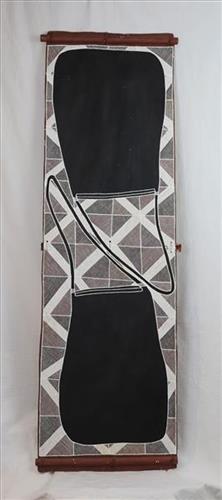377813282050911
Dillybag
The creation story in West Arnhem centres on a female ancestor, the mother known as Yingana, who emerged from the Arafura Sea and travelled across the inland regions. Yingana gave birth to the Bininj, the people of this country, and taught them each their proper language. Suspended from a headband were many dilly bags that contained yams, which she planted and taught the Bininj how to harvest. As well as being of practical use, dilly bags are also of religious significance to Arnhem Land people. Dilly bags are said to be totemic objects and are associated with particular sites in the landscape.
The bags and baskets are made by the women.
Women of Arnhem Land go out bush to collect kunngobarn (Pandanus spiralis). It means that the ladies can keep an eye on country, maintain their relationships with the ancestors and possibly do some hunting along the way. Upon returning to the community the process of stripping the leaves to manageable size and dyeing it with natural dyes gives people time to sit together and talk. Children watch and learn at the same time.
The wet season is the perfect time to make baskets, as the Pandanus is fresh and full of water from the rains meaning plenty of new shoots. Only the newest shoots are suitable for stripping. At this time of year some colours, like purple, become available for a short time as different plants flower or fruit. You can tell wet season baskets by their vibrant colours and often their larger size.
Plants are collected for their colour properties.
Yellow-orange: Mandjurndum (the bright orange roots of the Pognolobus reticulatus bush) ( Stinky cheese fruit tree)
Brown: Wirdilwirdil (the red bulb of Haemadorum breviculae grass) or by adding ashes or a rusted object to mandjurndum.
Green: The growing shoot of the pandanus itself (Pandanus spiralis), boiled with the ashes of pandanus leaves.
Purple-pink Windilk (the seeds of the Haemodorum coccineum plant, related to Kangaroo Paw) or the Rosella plant.
Grey-Black – Manbedde (the leaves of the quinine bush, Petalostigma pubescens)
The string dilly bag, is a large woven collecting basket. These large baskets or bags are often made from the vine Malasia scandens, a strong pliable plant which grows along the floor and into the canopy of monsoon vine thickets, the sand palm or stringy bark tree. The baskets are used to collect a variety of heavy foods such as fish caught in conical fish traps, or large collections of yams.
Traditional bush honey collecting bags can also be made from Pandanus spiralis. These dilly bags are very finely made, tightly woven collecting baskets. They are often used to collect sugarbag—the native honey.
The tightly woven surface painted with natural pigments, again imparting a ceremonial association. Woven and dyed dilly bags were commonly used for hunting and the containment of personal possessions, whereas painted bags are more commonly the domain of ceremony. These bags, however, have a break in the painted bands towards the back end of the bag, (as often woven ridges of more sculpted bags are also broken at the back) to allow a smooth surface which is the area in contact with the wearer’s body.
The close weave is indicative of honey-collecting bags made for hunting sugar bag or wild/bush honey. In addition to a tight weave, the embedding of wax into the base ensures a ‘fluid-tight’ vessel.



